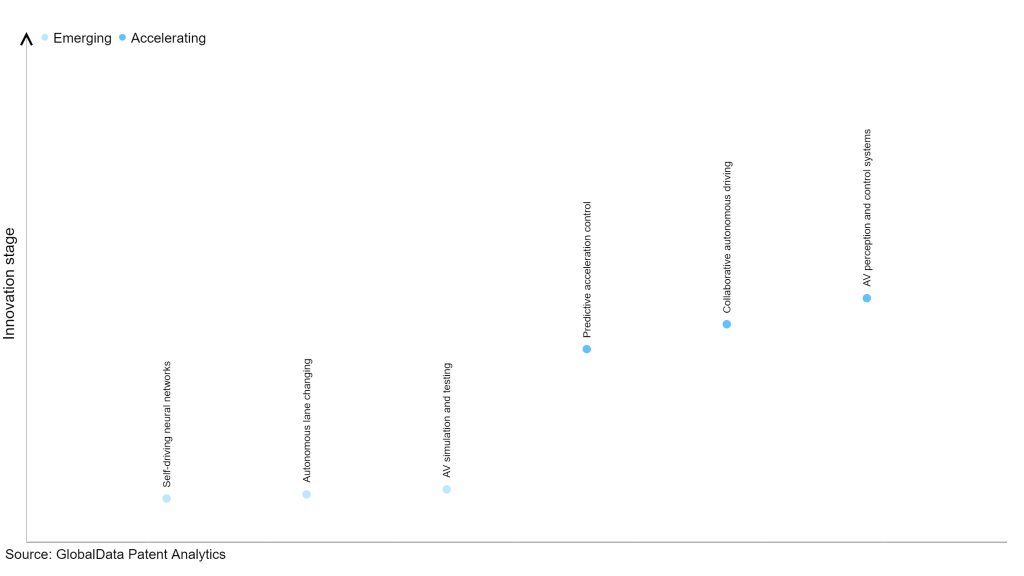The automotive industry continues to be a hotbed of patent innovation. Innovation in autonomous vehicles (AV) trajectory prediction is crucial for the automotive industry to improve safety, performance, cost, and compliance with regulations. AVs need to anticipate other vehicles’ movements and make safe decisions, while AV trajectory prediction can help them plan routes effectively in challenging conditions. As technology improves and economies of scale are achieved, AV trajectory prediction can reduce production costs and ensure AVs comply with global regulations. The automotive industry is utilizing deep learning algorithms to train autonomous vehicles to predict pedestrian and other vehicle trajectories. Multi-sensor fusion and predictive control algorithms help AVs navigate safely, while edge computing enables real-time decision-making to avoid collisions. In the last three years alone, there have been over 720,000 patents filed and granted in the automotive industry, according to GlobalData’s report on Artificial intelligence in automotive: AV trajectory prediction. Buy the report here.
However, not all innovations are equal and nor do they follow a constant upward trend. Instead, their evolution takes the form of an S-shaped curve that reflects their typical lifecycle from early emergence to accelerating adoption, before finally stabilizing and reaching maturity.
Identifying where a particular innovation is on this journey, especially those that are in the emerging and accelerating stages, is essential for understanding their current level of adoption and the likely future trajectory and impact they will have.
300+ innovations will shape the automotive industry
According to GlobalData’s Technology Foresights, which plots the S-curve for the automotive industry using innovation intensity models built on over one million patents, there are 300+ innovation areas that will shape the future of the industry.
Within the emerging innovation stage, self-driving neural networks, autonomous lane changing and AV simulation and testing are disruptive technologies that are in the early stages of application and should be tracked closely. Predictive acceleration control, collaborative autonomous driving, and AV perception and control systems are some of the accelerating innovation areas, where adoption has been steadily increasing.
Innovation S-curve for artificial intelligence in the automotive industry

AV trajectory prediction is a key innovation area in artificial intelligence
Aautonomous vehicle trajectory prediction refers to the process of predicting the path or direction of movement of an autonomous vehicle based on a variety of data inputs, including sensor data, driving behavior models, road information, and the movement of neighboring vehicles. This prediction can be used to control the AV in a safe and efficient manner, avoiding potential obstacles or hazards on the road.
GlobalData’s analysis also uncovers the companies at the forefront of each innovation area and assesses the potential reach and impact of their patenting activity across different applications and geographies. According to GlobalData, there are 45+ companies, spanning technology vendors, established automotive companies, and up-and-coming start-ups engaged in the development and application of AV trajectory prediction.
Key players in AV trajectory prediction – a disruptive innovation in the automotive industry
‘Application diversity’ measures the number of applications identified for each patent. It broadly splits companies into either ‘niche’ or ‘diversified’ innovators.
‘Geographic reach’ refers to the number of countries each patent is registered in. It reflects the breadth of geographic application intended, ranging from ‘global’ to ‘local’.
Patent volumes related to AV trajectory prediction
Source: GlobalData Patent Analytics
Intel, the top patent filer in autonomous vehicle trajectory prediction, has filed a system and method for autonomous vehicle trajectory prediction using a hybrid deep learning model. This innovative approach combines a neural network trained to predict other vehicles' and pedestrians' trajectories with a second network trained to predict the autonomous vehicle's trajectory. This patent is part of Intel's ongoing efforts to advance autonomous vehicle technology. The patent could accelerate the development and deployment of safe and reliable autonomous vehicles by providing a more accurate prediction of AV trajectories. Baidu and Alphabet are some of the other key patent filers in AV trajectory prediction.
In terms of application diversity, Toshiba leads the pack. Qualcomm and FiveAI stood in the second and third positions respectively. By means of geographic reach, Intel held the top position followed by Hitachi and Stradvision.
To further understand the key themes and technologies disrupting the automotive industry, access GlobalData’s latest thematic research report on Artificial Intelligence (AI) in Automotive.
Data Insights
From

The gold standard of business intelligence.
Blending expert knowledge with cutting-edge technology, GlobalData’s unrivalled proprietary data will enable you to decode what’s happening in your market. You can make better informed decisions and gain a future-proof advantage over your competitors.



